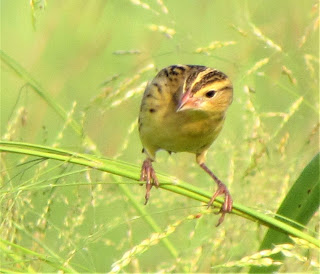The local birders were out in full force this morning,
spanning from the east to the north coast. Even though we did not visit all of
the birding areas, we recorded over 40 species, including a few rare ones.
The North
My son Jason and I, visited the northern parish of St. Lucy. It was a complete
contrast to the last time I visited. Then everything was dry, now, every location we visited had water, with some even full to the
brink. This was because of the downpour of rain we had during the last week. Many shorebirds were
around , with us recording over 10 species including a <>rare Killdeer (Charadrius vociferus). The ducks are
still arriving and we counted 31 Blue-winged
Teals (Spatula discors) at one location. As the water
settles and Dragonflies, fish, and tadpoles begin to strive in them, I am sure
the number of birds will increase.
The East
John Webster, Ed Massiah, Jason and I all visited eastern
parishes. John spent most of his time at Greenland collecting images - stills,
and motion on a rare male Northern
Pintail (Anas acuta) at that pond. He also drew
our attention to a duck he saw there that was much like a female Blue-winged
Teal but had a very light-colored belly/underbody when compared to the Blue-winged Teal. It
was also somewhat smaller.
Ed went to the eastern parish of St. Philip to see a pair of
Ruffs, first seen by John two days ago. Sadly he did
not see them but saw over 40 Black-bellied Plovers and over 50 Semipalmated Sandpiper
and a semirare Western Sandpiper.
Jason and I added another an eastern rarity to the list and
a lifer for him. We saw a juvenile Purple Gallinule at Redlands Irrigation Pond
in the parish of St John.
A good morning of birding was had by all. Below are the birds we saw.
- Blue-winged Teal - Spatula discors
- Northern Pintail Anas acuta
- Scaly-naped Pigeon - Patagioenas squamosa
- Eurasian Collared-Dove - Streptopelia decaocto
- Common Ground Dove - Columbina passerina
- Zenaida Dove - Zenaida aurita
- Common Gallinule - Gallinula galeata
- Green-throated Carib - Eulampis holosericeus
- Antillean Crested Hummingbird - Orthorhyncus cristatus
- Purple Gallinule - Porphyrio martinica
- Black-bellied Plover - Pluvialis squatarola
- Semipalmated Plover - Charadrius semipalmatus
- Killdeer - Charadrius vociferus
- Stilt Sandpiper - Calidris himantopus
- Ruddy Turnstone - Arenaria interpres
- Least Sandpiper - Calidris minutilla
- White-rumped Sandpiper - Calidris fuscicollis
- Semipalmated Sandpiper - Calidris pusilla
- Western Sandpiper - Calidris mauri
- Short-billed Dowitcher - Limnodromus griseus
- Wilson's Snipe - Gallinago delicata
- Spotted Sandpiper Actitis macularius
- Solitary Sandpiper - Tringa solitaria
- Greater Yellowlegs - Tringa melanoleuca
- Lesser Yellowlegs - Tringa flavipes
- Magnificent Frigatebird - Fregata magnificens
- Great Egret - Ardea alba
- Snowy Egret Egretta thula
- Green Heron - Butorides virescens
- Black-crowned Night-Heron - Nycticorax nycticorax
- Belted Kingfisher - Megaceryle alcyon
- Caribbean Elaenia - Elaenia martinica
- Gray Kingbird - Tyrannus dominicensis
- Black-whiskered Vireo - Vireo altiloquus
- Shiny Cowbird - Molothrus bonariensis
- Carib Grackle - Quiscalus lugubris
- Yellow Warbler - Setophaga petechia
- Barn Swallow - Hirundo rustica
- Grassland Yellow-Finch - Sicalis luteola
- Bananaquit - Coereba flaveola
- Barbados Bullfinch - Loxigilla barbadensis
- Black-faced Grassquit - Melanospiza bicolor
































